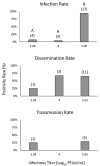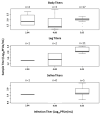Vector Competence of Florida Culicoides insignis (Diptera: Ceratopogonidae) for Epizootic Hemorrhagic Disease Virus Serotype-2
- PMID: 33807536
- PMCID: PMC7998304
- DOI: 10.3390/v13030410
Vector Competence of Florida Culicoides insignis (Diptera: Ceratopogonidae) for Epizootic Hemorrhagic Disease Virus Serotype-2
Abstract
Epizootic hemorrhagic disease virus (EHDV; family Reoviridae, genus Orbivirus) is an arthropod-borne virus of ungulates, primarily white-tailed deer in North America. Culicoides sonorensis, the only confirmed North American vector of EHDV, is rarely collected from Florida despite annual virus outbreaks. Culicoides insignis is an abundant species in Florida and is also a confirmed vector of the closely related Bluetongue virus. In this study, oral challenge of C. insignis was performed to determine vector competence for EHDV serotype-2. Field-collected female midges were provided bovine blood spiked with three different titers of EHDV-2 (5.05, 4.00, or 2.94 log10PFUe/mL). After an incubation period of 10 days or after death, bodies and legs were collected. Saliva was collected daily from all females from 3 days post feeding until their death using honey card assays. All samples were tested for EHDV RNA using RT-qPCR. Our results suggest that C. insignis is a weakly competent vector of EHDV-2 that can support a transmissible infection when it ingests a high virus titer (29% of midges had virus positive saliva when infected at 5.05 log10PFUe/mL), but not lower virus titers. Nevertheless, due to the high density of this species, particularly in peninsular Florida, it is likely that C. insignis plays a role in the transmission of EHDV-2.
Keywords: Orbivirus; Reoviridae; arboviruses.
Conflict of interest statement
The authors declare no conflict of interest.
Figures



Similar articles
-
Field data implicating Culicoides stellifer and Culicoides venustus (Diptera: Ceratopogonidae) as vectors of epizootic hemorrhagic disease virus.Parasit Vectors. 2019 May 23;12(1):258. doi: 10.1186/s13071-019-3514-8. Parasit Vectors. 2019. PMID: 31122295 Free PMC article.
-
Vector competence of Culicoides sonorensis (Diptera: Ceratopogonidae) to epizootic hemorrhagic disease virus serotype 7.Parasit Vectors. 2012 Oct 17;5:236. doi: 10.1186/1756-3305-5-236. Parasit Vectors. 2012. PMID: 23075098 Free PMC article.
-
Vector Competence of Culicoides sonorensis (Diptera: Ceratopogonidae) for Epizootic Hemorrhagic Disease Virus Serotype 2 Strains from Canada and Florida.Viruses. 2019 Apr 22;11(4):367. doi: 10.3390/v11040367. Viruses. 2019. PMID: 31013588 Free PMC article.
-
Perspectives on the Changing Landscape of Epizootic Hemorrhagic Disease Virus Control.Viruses. 2021 Nov 12;13(11):2268. doi: 10.3390/v13112268. Viruses. 2021. PMID: 34835074 Free PMC article. Review.
-
Management of North American Culicoides Biting Midges: Current Knowledge and Research Needs.Vector Borne Zoonotic Dis. 2015 Jun;15(6):374-84. doi: 10.1089/vbz.2014.1705. Vector Borne Zoonotic Dis. 2015. PMID: 26086558 Review.
Cited by
-
A Review of the Vector Status of North American Culicoides (Diptera: Ceratopogonidae) for Bluetongue Virus, Epizootic Hemorrhagic Disease Virus, and Other Arboviruses of Concern.Curr Trop Med Rep. 2022;9(4):130-139. doi: 10.1007/s40475-022-00263-8. Epub 2022 Sep 10. Curr Trop Med Rep. 2022. PMID: 36105115 Free PMC article. Review.
-
Oviposition of Culicoides insignis (Diptera: Ceratopogonidae) under laboratory conditions with notes on the developmental life history traits of its immature stages.Parasit Vectors. 2021 Oct 9;14(1):522. doi: 10.1186/s13071-021-05025-5. Parasit Vectors. 2021. PMID: 34627349 Free PMC article.
-
Epidemiological Analyses of the First Incursion of the Epizootic Hemorrhagic Disease Virus Serotype 8 in Tunisia, 2021-2022.Viruses. 2024 Feb 27;16(3):362. doi: 10.3390/v16030362. Viruses. 2024. PMID: 38543728 Free PMC article.
-
Laboratory and field assays indicate that a widespread no-see-um, Culicoides furens (Poey) is susceptible to permethrin.Sci Rep. 2025 Feb 8;15(1):4698. doi: 10.1038/s41598-025-89520-0. Sci Rep. 2025. PMID: 39922977 Free PMC article.
-
Epizootic Hemorrhagic Disease Virus: Current Knowledge and Emerging Perspectives.Microorganisms. 2023 May 19;11(5):1339. doi: 10.3390/microorganisms11051339. Microorganisms. 2023. PMID: 37317313 Free PMC article. Review.
References
-
- Ruder M.G., Lysyk T.J., Stallknecht D.E., Foil L.D., Johnson D.J., Chase C.C., Dargatz D.A., Gibbs E.P.J. Transmission and epidemiology of Bluetongue and Epizootic Hemorrhagic Disease in North America: Current perspectives, research gaps, and future directions. Vector-Borne Zoonotic Dis. 2015;15:348–363. doi: 10.1089/vbz.2014.1703. - DOI - PubMed
Publication types
MeSH terms
LinkOut - more resources
Full Text Sources
Other Literature Sources

